Day 251 - Jan 29 - Orlando Day Off More...
To start off today's words of confusion and uselessness I will start with something that is neither confused nor useless. As you all know perpetuation and preservation of the roadie breed is of the utmost importance. Unfortunately not all can always be a shangri-la of smiles in roadie world and occasionally the big hammer of crushing reality enters our roadie world to test our voracity and strength. So with a concerned and well wishing heart I present some difficult news. A friend of many and long time amazing sound roadie named Gungi has been diagnosed with cancer a little while back. While much has been done within the roadie community to assist him and other roadies with life challenges I thought that given the wonderful group of friends that share my travels, I would share some info to those that may be curious enough to take a look and perhaps assist. If so, take a look at http://www.friendsofgungi.com.
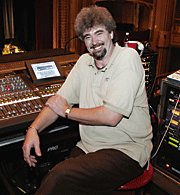
So, our day off in Orlando has us staying at an oh so joyfully located hotel that is part of the Universal Studios compound out here.
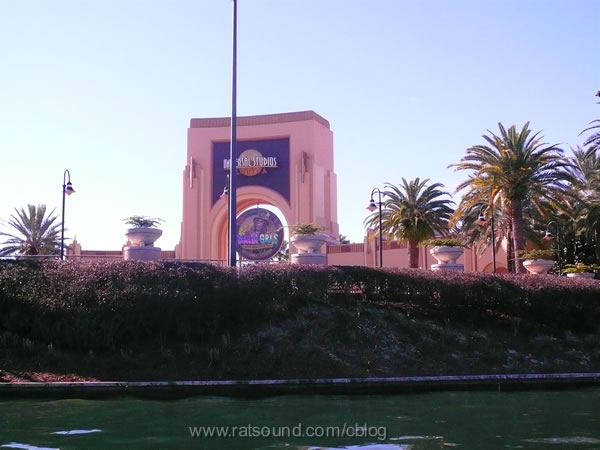
Oh joy! The coldest day Florida has seen in 40 years and we are shacked up at a tourist trap that is a virtual ghost town a 20 minute cab ride from anything that is not big piles of fake marketing crap. The water taxi was the thrill of day, so thrilling that we decided to walk back to the hotel after eating lunch in order not to over thrill ourselves in one day.
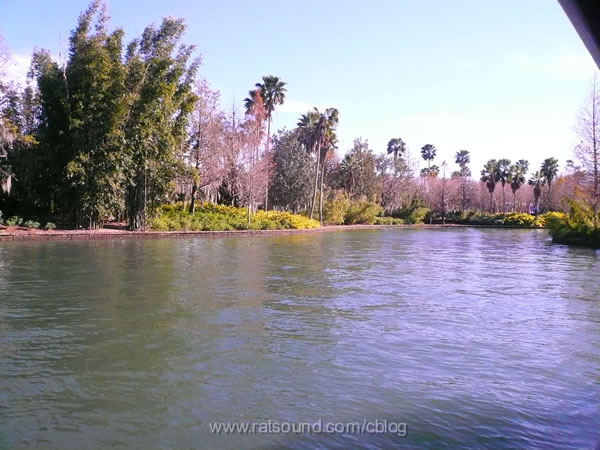
Welcome back to another fascinating slow motion interactive segment of...
Dear Ratty!
**** Warning! Techno Babble Below ****
Posted by janedoe2
Dear Ratty,
Considering the size of your sound board, I always wondered if you have to make constant adjustments during each song throughout the concert, or do you have some sort of preprogrammed set up that handles some of the load once you get a look at the set list? I also wonder if digital boards are made with analog parts?
signed,
Puzzled.
Dear Puzzled,
I do make some adjustments during the show. Mainly I set up each song, which involves making some changes in levels to compensate for things like different guitars, effects, who sings and song speed etc. Also, during the songs I make some changes to compensate for level variations related to how hard or soft each person is playing or various cues like solos or effects All in all, compared to most sound engineers, I do relatively little though. Nothing is programs though and all the things I do are done manually by hand and I do not use preset scenes.
As far as digital vs analog, I would first like to clarify that the terms digital and analog typically refers to how the sound is dealt with rather than the parts used. In an analog piece of audio gear the audio travels through wires and things and stays relatively intact as a version of the original signal. Digital typically refers to a process where the analog signal is converted into series of numerical representations. These numeric representations are then moved around and altered as needed and at the end of the signal chain those numeric representations are interpreted back into an analog signal and run through a speaker for our ears to hear.
An analogy that may help clarify would be to imagine we have a piece of paper with a intricate hand painted water color artwork drawn upon it and it is the "analog" original creation that we are dealing with. We now want to send this painting to someone that is elsewhere and for this example, lets say we only have two viable sending choices. One method is to hire a courier and have it delivered to the recipient which I will equate to an "analog delivery". The other choice we have is to scan it and have the artwork converted to a digital representation of the original which is then emailed, and then the recipient prints it out creating a an analog final product that is very similar to the original.
Each of these methods offer advantages and detriments. By scanning the document, depending quality of the scanner (A to D converter) and printer (D to A converter), a nearly exact copy can be created on the receiving end. Plus, once digitized email format, the writings can be forwarded via email over and over again and each time it will be a near perfect representation of the original. Whereas with the courier method, each time the artwork is forwarded and admired by someone, it picks up a smudge and over time begins to get worn out and degrades over time. That degradation can occur quite quickly if much care is not taken at every step in the documents journey and eventually the readability can be lost, sort of like how analog audio degrades when it goes through too many pieces of gear or poor quality gear or if care is not taken to have everything set up properly.
On the surface it would seem that digital is a clearly superior choice but looking deeper, there is more than meets the ear. The painting in reality consists of more than just colors and patterns. What about the texture, thickness and feel of the paper it was painted on? does the paper reek of smoke or perhaps have an essence of perfume? Is the paper wrinkled or warped from the water when painted? Even though scanners and printers do an incredible job of capturing and recreating, they are far from perfect and I will venture to say that with any relatively complex document , it would not be very difficulty to differentiate the original from the scanned copy when held side by side. Of course if enough time, care and expense is allowed, some or many of these nuances can also be approximated to a higher and higher degree of perfection so that the final reproduction is closer to the original. That 'striving for a perfect recreation of the analog original" is what the designers of digital equipment are striving to do. As the quality of digital continues to reach new levels and as it improves, it keeps getting closer and closer to the analog original with fewer and fewer concessions made due to technology limitations or cost. But the fact remains, "no matter how perfect you digitize and then recreate a copy of the original, it will never be as perfect as not digitizing it in the first place."
So, stepping back and looking at the decision about whether to convert something to digital really depends on many factors and opinions. If the artwork will get forwarded many times or if you need to do some complex manipulations or you need to store it away for a while, then digitizing offers strong advantages. If you are going to move it a relatively short distance or you have quality methods of handling the original as to minimize degradation, then quite often there is no reason to replicate the original when you can just use original.
Put into practical terms that I try and follow, I avoid converting to digital unless converting offers distinct advantages as it does with system processors. If I do let the signal enter the digital domain, I keep it there as long as possible and never convert the primary signal more than once in and out of digi because it is just plain silly to keep making copies of copies. Also, when I do convert the primary signal to digital, I try and do in such a way that it does not sound displeasing to me, I use the complex method of listening to determine this part. That is about as far as the analogy will take us but hopefully that brings some clarity to the lucky humans that are not cursed with the techno gene.
-- Ratty
User Name: Justin Slazas
Dave,
As a fellow engineer, I am very happy to see you offer up your tips and tricks to the curious. I have had the pleasure to work with some of the tops in the industry. The one thing I noticed that they all have in common, is a love to teach. I love to learn and this blog is no exception. I will confess that on a late sleepless night, in china on a corporate gig, while surfing away on the web, I ran into your blog and have been hooked ever since. So here is my chance to ask a couple questions.
When you start tuning for the room, do you smaart or do you throw on one of your favorite tunes? What tunes do you like to tune to? What bands are you jamming on your Ipod right now? What is your go to program for the current Peppers V-Dosc rig. And last but not least, just in case I run into you on a gig some where down the road, what is your favorite drink?
Thanks for all the great insight, I will post more technical questions later on.
Regards,
Justin
Good thinking Justin!
I currently am drinking red wine as the tough guy roadie drink of choice.
I do not use Smaart to tune but do use it when developing processor settings for MicroWedge etc... This far into tour, I do not play anything, I just stand in the venue and listen to the echo's of load in for a bit. I look at the seat coverings, shape of the arena and have a listen during the support act to figure out any aberrations. Lee, the FOH system tech, deals with making sure the PA is hung properly to cover the venue and matches up the various zones. For the most part, as long as we are in arenas, the main variations are room resonance and brightness. Everything else stays relatively constant. Tuning music when I do tune is typically Dub Syndicate "Echomania." As far as music I listen to on my non-iPod, well I leak that little by little in various blog days.
--Ratty
User Name: Jay Rigby
Comments:
Ah, just read your answer on the low mid eq and system processor which is very understandable. A different question for ya then. How do you feel about graphic eq vs. parametric eq on system eq's? One of our FOH techs here has been recently doing ALL of the system eq and house eq for venues in the XTA's. Even when something gets pulled from the graph he translates it into the parametric on the XTA and leaves the graphic flat all of the time. His reason is that the graphic eq throws the system out of phase. Any thoughts?
Greeting Jay,
I am fine with graphic EQ's, it is a tool just like everything else in the rig and with each tool I am faced with assets and issues. The graphic may be less than optimum in some respects but in it's usability more than makes up for it in my opinion. I personally do not have the time or patience mid rock show to be mucking around inside a digital system processor. I want to see everything, always. Ultimately, what really matters is "How good does the mix sound?" and "How quickly are problems and issues dealt with by the engineer when things go awry?" What ever tools an engineer uses to get there really makes no difference. So let the quality of the product produced determine the credibility of the opinion offered.
--Ratty
User Name: Ian
Comments:
How much planning is done for each venue? I imagine that the rigging and lighting guys have some work to do with points and such, but what's done on the acoustical side? Do you model each venue in EASE, or just guess the coverage?
Every show is "advanced" in great detail and everything from truck entry ways, roof load capacities, stage placement, seats to be sold, security to be supplied, local crew and on and on is arranged to assure that everything is dead on. Things do get screwed up occasionally but on this level of touring, the roadies really know what they are doing. As far as sound, the riggers arrange to get us hang points in the right spots and make sure the roof will support the weight or else we make adjustments in the system configuration to compensate. We do not use EASE but do use L'Acoustics three dimensional acoustic modeling software called SoundVision.
Each day, Lee comes in with a laser rangefinder and an inclinometer and takes the room dimensions and relevant shapes. This data is then input into the modeling software along with the quantity and type of speakers we want to use. He then works with the software to optimize venue coverage and volume levels. The software then generates the angles between the various boxes which is then implemented in the speaker arrays. The predictability and consistency is can be extremely good with an experience system tech like Lee and Nick the Fly.
Here are a few real life and 3d software shots from a stadium in Manchester that we played in 2004.
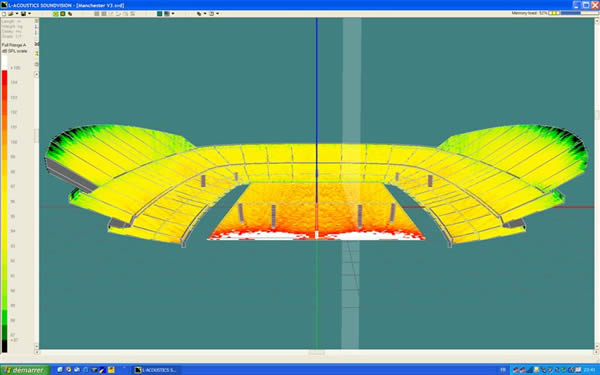
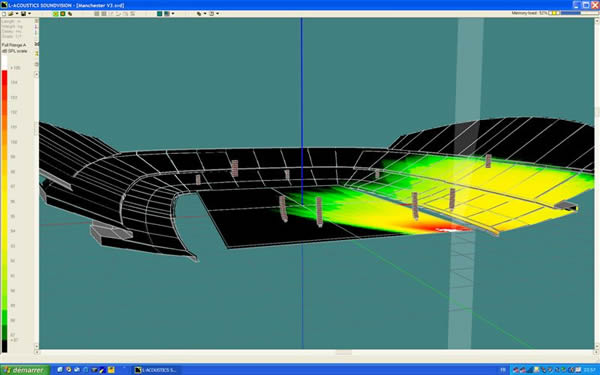
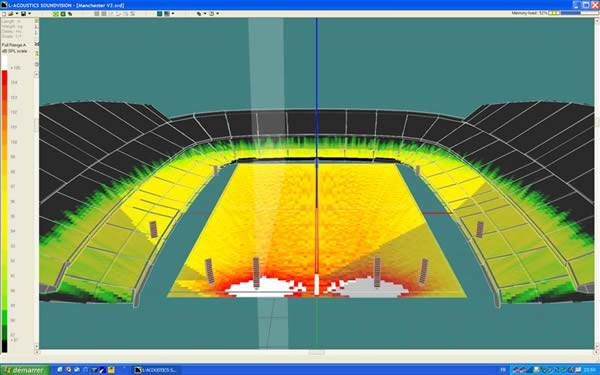
Here is a side view of the real deal, empty
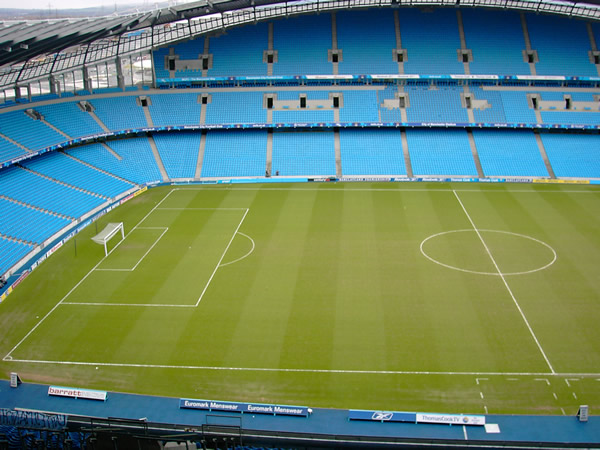
-- Ratty
Trackbacks
The author does not allow comments to this entry
Comments
Display comments as Linear | Threaded
Daniel Higgott on :